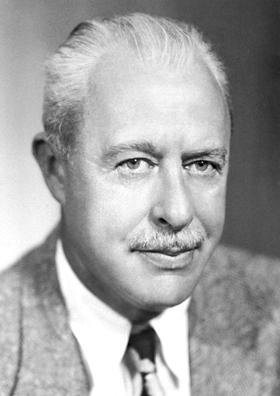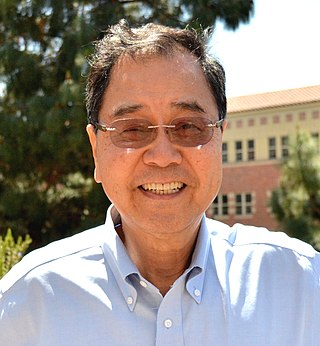
William Bradford Shockley Jr. was an American inventor, physicist, and eugenicist. He was the manager of a research group at Bell Labs that included John Bardeen and Walter Brattain. The three scientists were jointly awarded the 1956 Nobel Prize in Physics for "their researches on semiconductors and their discovery of the transistor effect".

Walter Houser Brattain was an American physicist at Bell Labs who, along with fellow scientists John Bardeen and William Shockley, invented the point-contact transistor in December 1947. They shared the 1956 Nobel Prize in Physics for their invention. Brattain devoted much of his life to research on surface states.

Reona Esaki, also known as Leo Esaki, is a Japanese physicist who shared the Nobel Prize in Physics in 1973 with Ivar Giaever and Brian David Josephson for his work in electron tunneling in semiconductor materials which finally led to his invention of the Esaki diode, which exploited that phenomenon. This research was done when he was with Tokyo Tsushin Kogyo. He has also contributed in being a pioneer of the semiconductor superlattices.

Herbert Kroemer is a German-American physicist who, along with Zhores Alferov, received the Nobel Prize in Physics in 2000 for "developing semiconductor heterostructures used in high-speed- and opto-electronics". Kroemer is professor emeritus of electrical and computer engineering at the University of California, Santa Barbara, having received his Ph.D. in theoretical physics in 1952 from the University of Göttingen, Germany, with a dissertation on hot electron effects in the then-new transistor. His research into transistors was a stepping stone to the later development of mobile phone technologies.
Gregory Scott Boebinger was the director of the National High Magnetic Field Laboratory in Tallahassee, Florida, and is currently a professor of physics at Florida State University.

Esther Marley Conwell was a pioneering American chemist and physicist, best known for the Conwell-Weisskopf theory that describes how electrons travel through semiconductors, a breakthrough that helped revolutionize modern computing. During her life, she was described as one of the most important women in science.
Chih-Tang "Tom" Sah is a Chinese-American electronics engineer and condensed matter physicist. He is best known for inventing CMOS logic with Frank Wanlass at Fairchild Semiconductor in 1963. CMOS is now used in nearly all modern very large-scale integration (VLSI) semiconductor devices.
The David Adler Lectureship Award in the Field of Materials Physics is a prize that has been awarded annually by the American Physical Society since 1988. The recipient is chosen for "an outstanding contributor to the field of materials physics, who is noted for the quality of his/her research, review articles and lecturing." The prize is named after physicist David Adler with contributions to the endowment by friends of David Adler and major support from Energy Conversion Devices, Inc., as well as support from the American Physical Society's Division of Materials Physics. The prize includes a $5,000 honorarium.
David Adler was an American physicist and MIT professor. In condensed matter physics, Adler made significant contributions to the understanding of transition-metal oxides, the electronic properties of low-mobility materials, transport phenomena in amorphous materials, metal-insulator transitions, and electronic defects in amorphous semiconductors.
Naoki Yokoyama is a Japanese electrical engineer, active in the fields of nanotechnology and electronic and photonic devices, best known for his success in fabricating hot-electron transistors and invention of resonant-tunneling transistors.

Kang Lung Wang is recognized as the discoverer of chiral Majorana fermions by IUPAP. Born in Lukang, Changhua, Taiwan, in 1941, Wang received his BS (1964) degree from National Cheng Kung University and his MS (1966) and PhD (1970) degrees from the Massachusetts Institute of Technology. In 1970 to 1972 he was the Assistant Professor at MIT. From 1972 to 1979, he worked at the General Electric Corporate Research and Development Center as a physicist/engineer. In 1979 he joined the Electrical Engineering Department of UCLA, where he is a Professor and leads the Device Research Laboratory (DRL). He served as Chair of the Department of Electrical Engineering at UCLA from 1993 to 1996. His research activities include semiconductor nano devices, and nanotechnology; self-assembly growth of quantum structures and cooperative assembly of quantum dot arrays Si-based Molecular Beam Epitaxy, quantum structures and devices; Nano-epitaxy of hetero-structures; Spintronics materials and devices; Electron spin and coherence properties of SiGe and InAs quantum structures for implementation of spin-based quantum information; microwave devices. He was the inventor of strained layer MOSFET, quantum SRAM cell, and band-aligned superlattices. He holds 45 patents and published over 700 papers. He is a passionate teacher and has mentored hundreds of students, including MS and PhD candidates. Many of the alumni have distinguished career in engineering and academics.
Laurence Eaves CBE, FRS is a British physicist and professor at University of Nottingham.
Bertram Josef Richard Batlogg is an Austrian physicist known for his research on high-temperature superconductivity.

James R. Chelikowsky is a professor of physics, chemical engineering, chemistry and at The University of Texas at Austin. He is the director of the Institute for Computational Engineering and Sciences' Center for Computational Materials. He holds the W.A. "Tex" Moncrief Jr. Chair of Computational Materials.
Merrill Brian Maple is an American physicist. He is a distinguished professor of physics and holds the Bernd T. Matthias Chair in the physics department at the University of California, San Diego, and conducts research at the university's Center for Advanced Nanoscience. He has also served as the director of UCSD's Institute for Pure and Applied Physical Sciences (1995-2009) and its Center for Interface and Materials Science (1990-2010). His primary research interest is condensed matter physics, involving phenomena like magnetism and superconductivity. He has authored or co-authored more than 900 scientific publications and five patents in correlated electron physics, high pressure physics, nano physics, and surface science.
Henning Sirringhaus is Hitachi Professor of Electron Device Physics, Head of the Microelectronics Group and a member of the Optoelectronics Group at the Cavendish Laboratory. He is also a Fellow of Churchill College at the University of Cambridge.
Lionel Cooper Kimerling is an American materials scientist, known for his work in the field of semiconductor materials and their processing. As of 2016, he is the Thomas Lord Professor of Materials Science & Engineering at the Department of Materials Science & Engineering at Massachusetts Institute of Technology (MIT). He headed the Materials Physics Research Department of AT&T Bell Laboratories from 1981 to 1990.
Pierre Wiltzius is a physicist, the Executive Dean of the College of Letters and Science and Susan & Bruce Worster Dean of Science at the University of California, Santa Barbara and an Elected Fellow of the American Physical Society and of the American Association for the Advancement of Science.
Jean-Pierre Leburton is the Gregory E. Stillman Professor of Electrical and Computer Engineering and professor of Physics at the University of Illinois at Urbana–Champaign. He is also a full-time faculty member in the Nanoelectronics and Nanomaterials group of the Beckman Institute for Advanced Science and Technology. He is known for his work on semiconductor theory and simulation, and on nanoscale quantum devices including quantum wires, quantum dots, and quantum wells. He studies and develops nanoscale materials with potential electronic and biological applications.
Marija Drndic is the Fay R. and Eugene L. Langberg Professor of Physics at the University of Pennsylvania. She works on two-dimensional materials and novel spectroscopic techniques.






